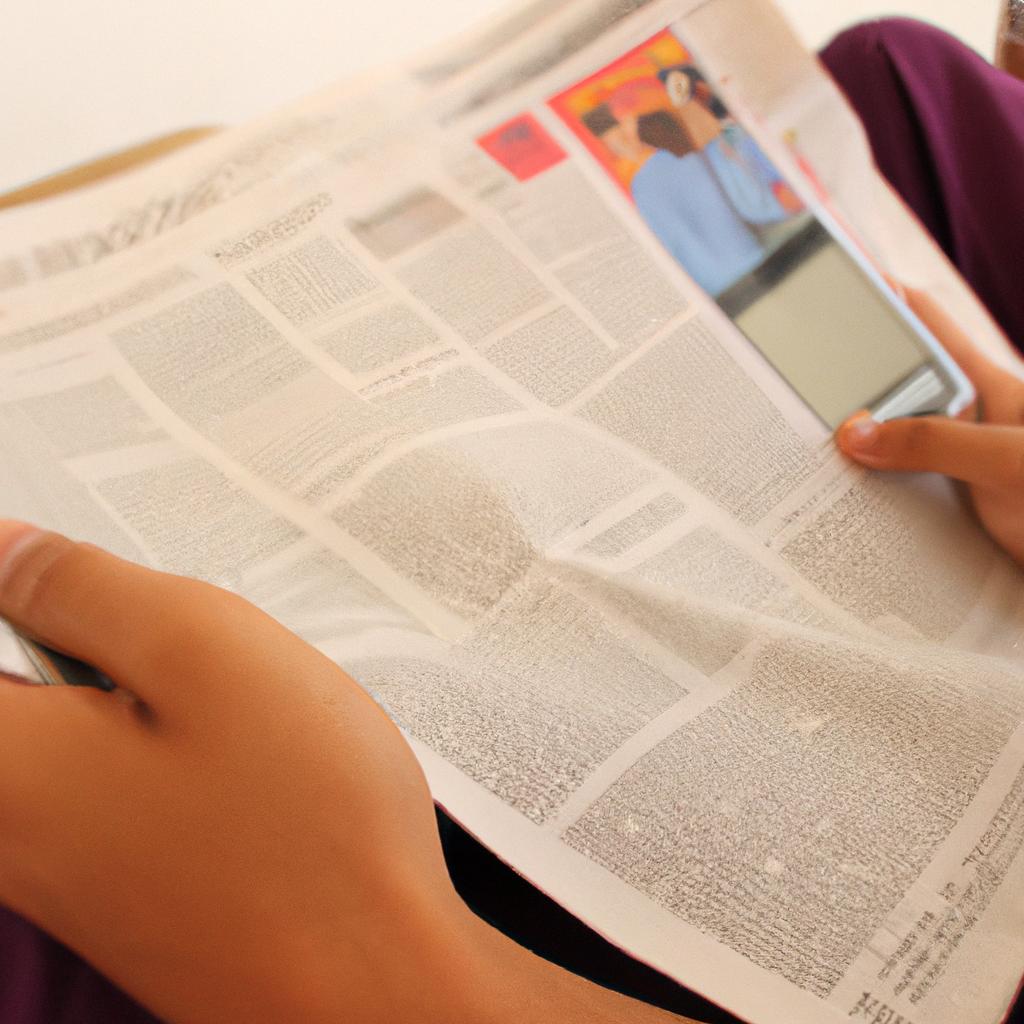In today’s digital age, the proliferation of fake news and misinformation has emerged as a significant challenge within the news media industry. The rapid spread of false information not only undermines the credibility of traditional news sources but also poses a threat to public trust in journalism. This article aims to examine the phenomenon of fake news and misinformation by focusing on the consumption patterns of news readers.
To illustrate the impact of fake news, consider a hypothetical scenario wherein an influential social media account disseminates an entirely fabricated story about a prominent political figure engaging in illegal activities. Despite being completely baseless, this story quickly goes viral, capturing the attention of millions of unsuspecting users who unknowingly perpetuate its reach through sharing and commenting. Such instances exemplify how easily manipulative content can infiltrate mainstream discourse and shape public opinion, highlighting the need for comprehensive research into understanding why individuals consume such misleading information and how it influences their perceptions of reality.
By delving into various factors that contribute to news consumption habits, including individual motivations, cognitive biases, and technological affordances, this article seeks to shed light on why people engage with fake news. Furthermore, it explores potential strategies that can be implemented at both individual and societal levels to mitigate the detrimental effects of misinformation in order to foster more informed and critical news consumption.
One key aspect to understanding why individuals consume fake news is the motivation behind their information-seeking behavior. Research suggests that people may gravitate towards sensational or emotionally appealing content, as it tends to evoke strong reactions and capture attention. Additionally, confirmation bias plays a role, as individuals often seek out information that aligns with their preexisting beliefs and values, even if it is inaccurate.
Cognitive biases also contribute to the consumption of fake news. For example, the illusory truth effect suggests that repeated exposure to false information can make it seem more credible over time. Similarly, selective exposure theory posits that individuals tend to seek out information that confirms their existing beliefs while avoiding conflicting viewpoints.
Technological affordances further exacerbate the spread of misinformation. Social media platforms rely on algorithms that prioritize engagement and user interaction, which can inadvertently amplify misleading content. The ease of sharing and amplifying information without fact-checking contributes to the rapid dissemination of fake news.
To mitigate the negative effects of misinformation, efforts are required at both individual and societal levels. At an individual level, media literacy education is crucial in teaching individuals how to critically evaluate sources, fact-check information before sharing it, and recognize common tactics used in spreading fake news. Fact-checking organizations play a vital role in debunking false stories and providing accurate information.
At a societal level, collaboration between technology companies, policymakers, and journalists is essential. Platforms need to invest in robust algorithms that prioritize accuracy over virality. Policymakers can work towards establishing regulations to hold platforms accountable for the spread of misinformation. Journalists must maintain ethical standards by fact-checking information before publishing stories.
In conclusion, understanding why individuals consume fake news requires examining various factors such as motivations, cognitive biases, and technological affordances. By addressing these factors through media literacy education, fact-checking initiatives, improved platform algorithms, and policy interventions, we can minimize the impact of fake news and promote a more informed and critical news consumption culture.
Definition of Fake News
Fake news refers to false or misleading information presented as factual news. It is a term that gained prominence in recent years due to the rapid spread of misinformation facilitated by digital media platforms. While fake news can take many forms and be found across various mediums, it predominantly circulates through social media channels such as Facebook, Twitter, and YouTube.
To illustrate the impact of fake news, consider an example where a fabricated story about a popular celebrity goes viral on social media. This story claims that the celebrity has been involved in illegal activities, damaging their reputation and causing public outrage. Despite being entirely baseless, this false narrative spreads rapidly across different online communities and reaches a wide audience who may not question its authenticity. Consequently, the affected individual faces severe consequences including damaged personal relationships and potential harm to their career.
The prevalence of fake news poses significant challenges for individuals seeking accurate information. The consumption of false information can lead to detrimental effects on society as it influences public opinion, shapes political discourse, and fosters division among people. To highlight these implications further:
- Misinformation undermines trust in traditional news sources.
- False narratives can contribute to polarization within society.
- Inaccurate reporting may fuel conspiracy theories.
- Manipulative content can exploit vulnerable populations.
Table: Implications of Fake News
| Implication | Description |
|---|---|
| Undermines Trust | Fake news erodes confidence in established news outlets and creates skepticism towards journalistic integrity. |
| Fuels Polarization | False narratives often target specific groups or ideologies, exacerbating divisions between communities with opposing viewpoints. |
| Contributes to Conspiracy | Misinformation provides fodder for conspiracy theories, leading individuals to question widely accepted facts and engage in irrational beliefs or behaviors. |
| Exploits Vulnerable Groups | Manipulative content preys upon vulnerable populations by spreading false promises or narratives, potentially causing harm or exploitation. |
In summary, fake news refers to false or misleading information presented as factual news that circulates primarily through social media platforms. Its impact extends beyond mere misinformation, affecting trust in journalism, polarizing society, fueling conspiracy theories, and exploiting vulnerable populations. Recognizing the implications of fake news is crucial in understanding the need for effective measures to combat its proliferation.
Transitioning into the subsequent section on “Types of Misinformation in News Media,” it becomes evident that addressing fake news necessitates a deeper investigation into different forms of misinformation prevalent within the news media industry.
Types of Misinformation in News Media
Types of Misinformation in News Media
After discussing the definition and characteristics of fake news, we now turn our attention to exploring the various types of misinformation that are prevalent in the news media industry. To illustrate this further, let us consider a hypothetical example where a prominent news outlet publishes an article claiming that a new study has found a direct link between vaccinations and autism. This article quickly gains traction on social media platforms, leading to widespread panic among parents and fueling anti-vaccination sentiments.
Misinformation can take different forms and have varying degrees of impact on individuals and society as a whole. Here are some common types:
- False Information: Inaccurate facts or claims presented as truth without any evidence to support them.
- Misleading Content: Manipulating information by omitting crucial details or presenting it out of context, thereby distorting its true meaning.
- Satire/Parody: Deliberately humorous or exaggerated content meant for entertainment purposes but often mistaken as factual reporting.
- Biased Reporting: Presenting news with a particular slant or ideological bias, which may influence public opinion.
To better understand these types of misinformation, let’s consider the following table:
| Type of Misinformation | Description | Example |
|---|---|---|
| False Information | Spreading inaccurate facts without supporting evidence | A fabricated story about celebrities endorsing a product |
| Misleading Content | Distorting information through selective presentation | Quoting part of a speech out of context |
| Satire/Parody | Humorous content that is not intended to be taken seriously | A satirical article mocking political figures |
| Biased Reporting | Presenting news from a specific perspective | Selectively showcasing one side’s viewpoint in an issue |
It is important to note that these classifications are not mutually exclusive, and misinformation often combines multiple elements. The proliferation of such misleading information can have significant consequences on individuals, society, and democratic processes. In the subsequent section, we will delve into the effects of fake news on society.
Transitioning to the next section about “Effects of Fake News on Society,” it is crucial to understand how misinformation impacts various aspects of our lives and influences public perception and decision-making.
Effects of Fake News on Society
Section Title: Types of Misinformation in News Media
Misinformation in the news media industry is a growing concern that has far-reaching consequences. It not only affects individuals’ perception of reality but also undermines trust in journalism as a whole. By examining the various types of misinformation present in news consumption, we can better understand its impact on society.
One example of misinformation in news media involves false information spread during political campaigns. In this scenario, false claims or misleading statements are disseminated to influence public opinion and sway election outcomes. This manipulation of facts distorts the democratic process by shaping voters’ perspectives based on inaccurate or incomplete information.
- Misleading headlines designed for clickbait purposes.
- False statistics presented without proper context.
- Fabricated stories created to generate controversy or provoke emotional responses.
- Manipulated images or videos shared with deceptive intent.
This table illustrates how misinformation can evoke different emotional responses among news consumers:
| Emotional Response | Example |
|---|---|
| Fear | Spreading rumors about an impending crisis |
| Anger | Inciting hatred towards a particular group |
| Shock | Presenting shocking allegations without evidence |
| Disgust | Sharing fabricated stories involving immoral acts |
Understanding these forms of misinformation emphasizes the need for critical thinking skills when consuming news content. As consumers, it is essential to question sources, verify information independently, and evaluate credibility before accepting any claims at face value.
By exploring the types of misinformation prevalent in news media, we uncover the complex landscape surrounding information dissemination. This understanding sets the stage for examining factors contributing to the spread of fake news and devising effective strategies to combat its detrimental effects on society’s well-being and collective knowledge.
Factors Contributing to the Spread of Fake News
The impact of fake news on society is significant, but understanding the factors that contribute to its spread is equally crucial. By examining these underlying factors, we can gain insights into how fake news proliferates and consider strategies to counteract this phenomenon.
Consider the case study of a widely-shared false report claiming that a popular fast-food chain was using human meat in their burgers. Despite being entirely baseless, the story gained traction rapidly due to several key factors:
-
Sensationalism: Fake news often employs sensationalist tactics designed to grab attention and evoke emotional responses from readers. In this case, the shocking nature of the claim sparked immediate interest and generated widespread public discussion.
-
Confirmation bias: Individuals are more likely to accept information that aligns with their preexisting beliefs or opinions, even if such information lacks credibility. This predisposition allows fake news to thrive as it caters to people’s confirmation biases, reinforcing existing narratives or prejudices.
-
Social media algorithms: Online platforms prioritize content based on user engagement metrics, such as likes, shares, and comments. Consequently, fake news stories that resonate strongly with users tend to receive higher visibility and reach a larger audience through algorithmic amplification.
-
Lack of digital literacy: Limited critical thinking skills and an inability to distinguish between reliable sources and misinformation make individuals vulnerable targets for consuming and sharing fake news articles without verifying their authenticity first.
- Sensationalist headlines attract attention.
- Confirmation bias reinforces preconceived notions.
- Algorithmic prioritization promotes viral dissemination.
- Limited digital literacy makes individuals susceptible.
Additionally, visualizing these influences can help emphasize their significance effectively. The table below illustrates four key factors contributing to the spread of fake news:
| Factor | Description |
|---|---|
| Sensationalism | Employing provocative language or claims to capture readers’ attention. |
| Confirmation Bias | Individuals favoring information that confirms their existing beliefs. |
| Algorithmic Bias | Online platforms amplifying content based on user engagement metrics. |
| Lack of Literacy | Insufficient critical thinking skills and inability to discern misinformation. |
Understanding these factors is essential as we now delve into exploring methods to identify and combat fake news, providing individuals with the tools necessary to navigate an increasingly complex media landscape.
Methods to Identify and Combat Fake News
The spread of fake news and misinformation has become a concerning issue in today’s news media industry. With the rapid growth of digital platforms, it has become easier for false information to circulate quickly and reach a wide audience. In this section, we will explore some key factors that contribute to the spread of fake news.
Factors Contributing to the Spread of Fake News:
One prominent factor is the lack of fact-checking by both consumers and producers of news content. For example, imagine a scenario where an individual comes across a sensational headline on social media claiming that a popular celebrity has passed away due to COVID-19 complications. Without verifying the information through reliable sources, they directly share it with their friends and followers. This unchecked dissemination perpetuates the false narrative and contributes to its virality.
Additionally, clickbait headlines and misleading visuals play a significant role in propagating fake news. Advertisers and publishers often use eye-catching titles or manipulated images to attract readers’ attention without necessarily providing accurate information. As humans are naturally drawn towards novelty or controversy, such tactics exploit our cognitive biases, making us more susceptible to believing false narratives.
Social media algorithms further exacerbate the issue by prioritizing engagement rather than accuracy. Platforms like Facebook and Twitter are designed to keep users engaged for longer periods, as increased user activity generates revenue through advertisements. To achieve this goal, these algorithms tend to show people content similar to what they have previously interacted with – including posts containing misinformation. Consequently, individuals find themselves trapped within echo chambers where their beliefs are continuously reinforced instead of being challenged.
To shed light on how influential these factors can be in shaping public opinion, consider the following emotional responses associated with consuming fake news:
- Anxiety: False reports about health crises or natural disasters can create panic among individuals who believe them.
- Anger: Misleading stories may provoke anger towards specific individuals or groups, leading to social tension and hostility.
- Confusion: Inaccurate information can confuse individuals who struggle to distinguish between what is true and false.
- Mistrust: The constant exposure to fake news erodes trust in media organizations, hindering their ability to deliver accurate news.
To further understand the impact of these factors, let us consider a hypothetical scenario where misinformation about a flu vaccine spreads rapidly through various online platforms. This table summarizes the consequences of this misinformation:
| Consequence | Description |
|---|---|
| Decreased Vaccination | Individuals may choose not to get vaccinated due to unfounded fears. |
| Increased Illness Rate | Without vaccination, more people could become ill from the flu. |
| Overwhelmed Healthcare | Higher illness rates strain healthcare systems during flu seasons. |
| Loss of Public Trust | Misinformation undermines confidence in public health authorities. |
Importance of Critical Thinking in News Consumption:
Understanding the factors contributing to the spread of fake news highlights the need for critical thinking skills when consuming news content. By critically evaluating sources, verifying information, and actively engaging with diverse perspectives, individuals can protect themselves from falling prey to false narratives.
Developing critical thinking skills is essential not only for avoiding misinformation but also for cultivating an informed society capable of navigating complex issues intelligently
Importance of Critical Thinking in News Consumption
Transitioning from the previous section’s exploration of methods to identify and combat fake news, we now delve into the importance of critical thinking in news consumption. By cultivating critical thinking skills, individuals can better navigate the vast landscape of information available today and distinguish facts from misinformation or biased narratives.
To illustrate this point, let us consider a hypothetical scenario: John is an avid news consumer who comes across an article claiming that a new study has found a direct link between coffee consumption and cancer. The headline catches his attention, but instead of blindly accepting it as truth, he engages in critical evaluation. He considers factors such as the credibility of the source, potential conflicts of interest, and whether other reputable studies have reached similar conclusions. Through thoughtful analysis, John discovers that the study was conducted by a small organization with ties to the coffee industry and contradicts numerous well-established scientific findings. This exercise in critical thinking helps John avoid being misled by sensationalized claims.
Emphasizing the significance of critical thinking in our daily lives is crucial for fostering media literacy and responsible news consumption. Here are some key reasons why:
- Empowering informed decision-making: Critical thinking equips individuals with the ability to assess information objectively, enabling them to make sound decisions based on reliable evidence rather than unfounded claims.
- Countering confirmation bias: By encouraging critical examination of different perspectives, people can challenge their own biases and preconceived notions, promoting a more nuanced understanding of complex issues.
- Safeguarding against manipulation: In an era where misinformation campaigns seek to exploit emotions and mold public opinion, developing strong critical thinking skills serves as a defense mechanism against manipulative tactics.
- Promoting social cohesion: When individuals engage critically with diverse viewpoints, they foster constructive dialogue and create opportunities for empathy building among communities that may hold differing opinions.
To further highlight these points visually, here is a table showcasing how critical thinking impacts various aspects of news consumption:
| Impact of Critical Thinking in News Consumption |
|---|
| Empowers informed decision-making |
| Counters confirmation bias |
| Safeguards against manipulation |
| Promotes social cohesion |
In summary, critical thinking plays a vital role in mitigating the spread and influence of fake news. By actively engaging with information through a critical lens, individuals can better discern between reliable sources and misinformation. This practice empowers them to make informed decisions while safeguarding themselves against manipulation. Ultimately, fostering critical thinking skills contributes to more responsible and well-rounded news consumption within society.




